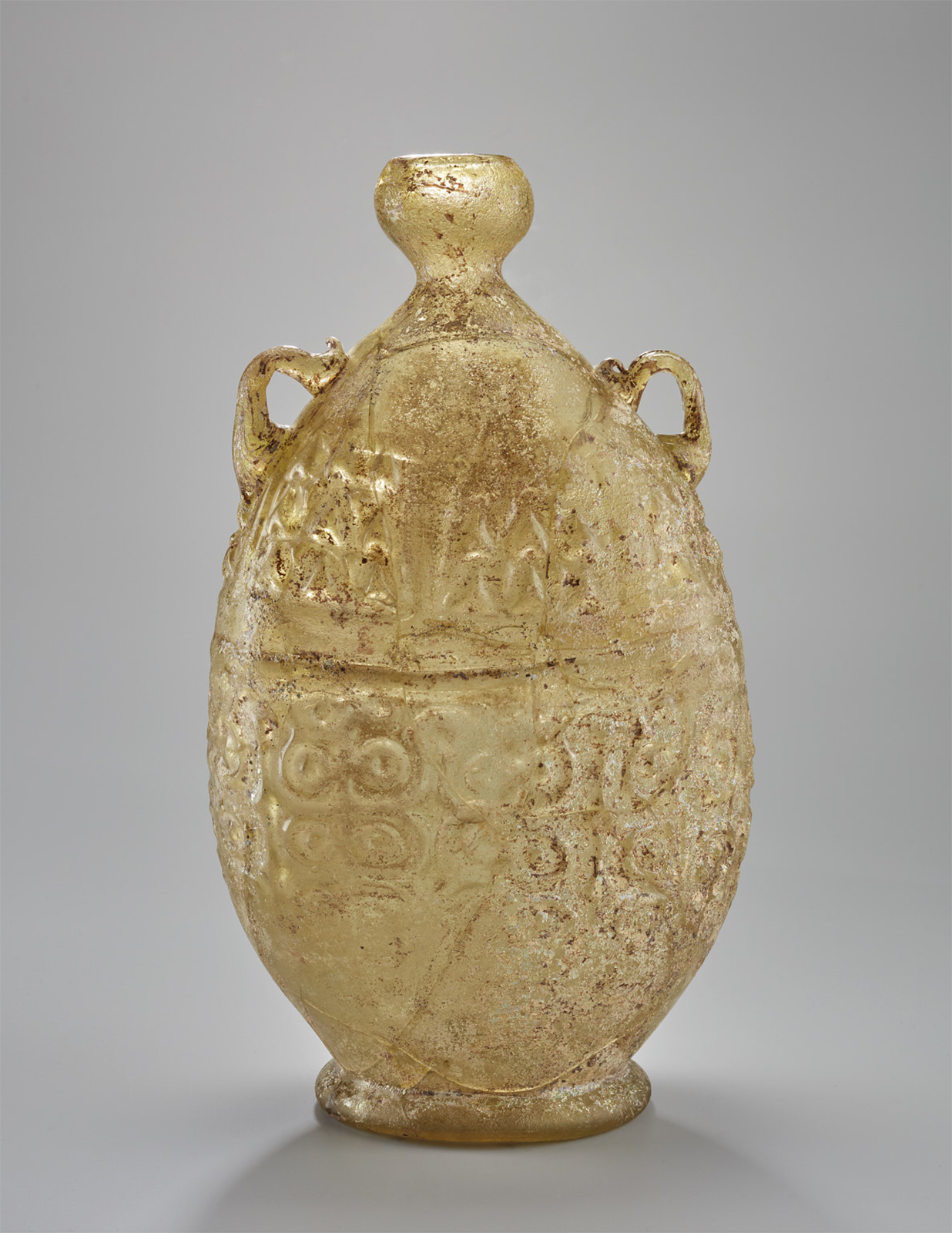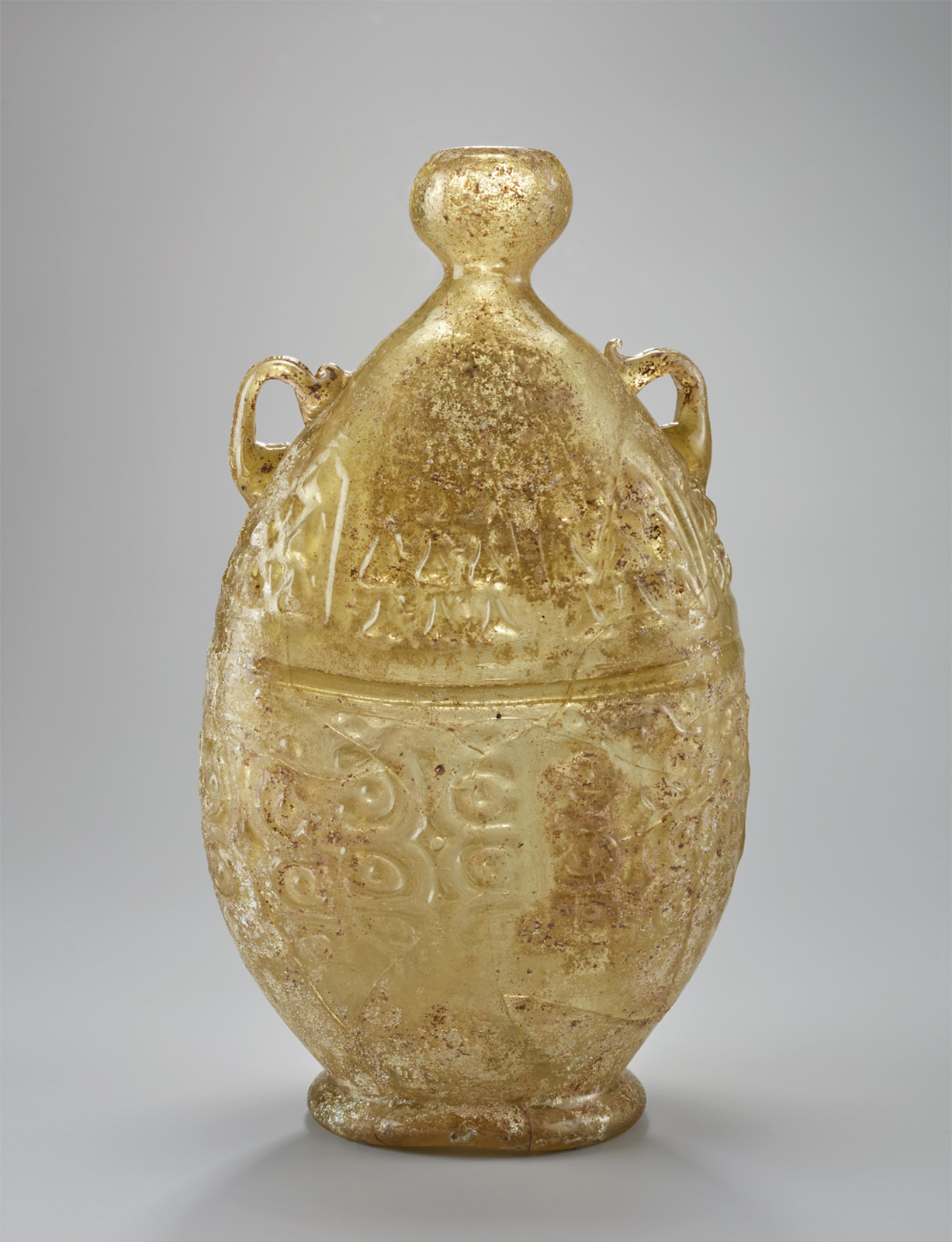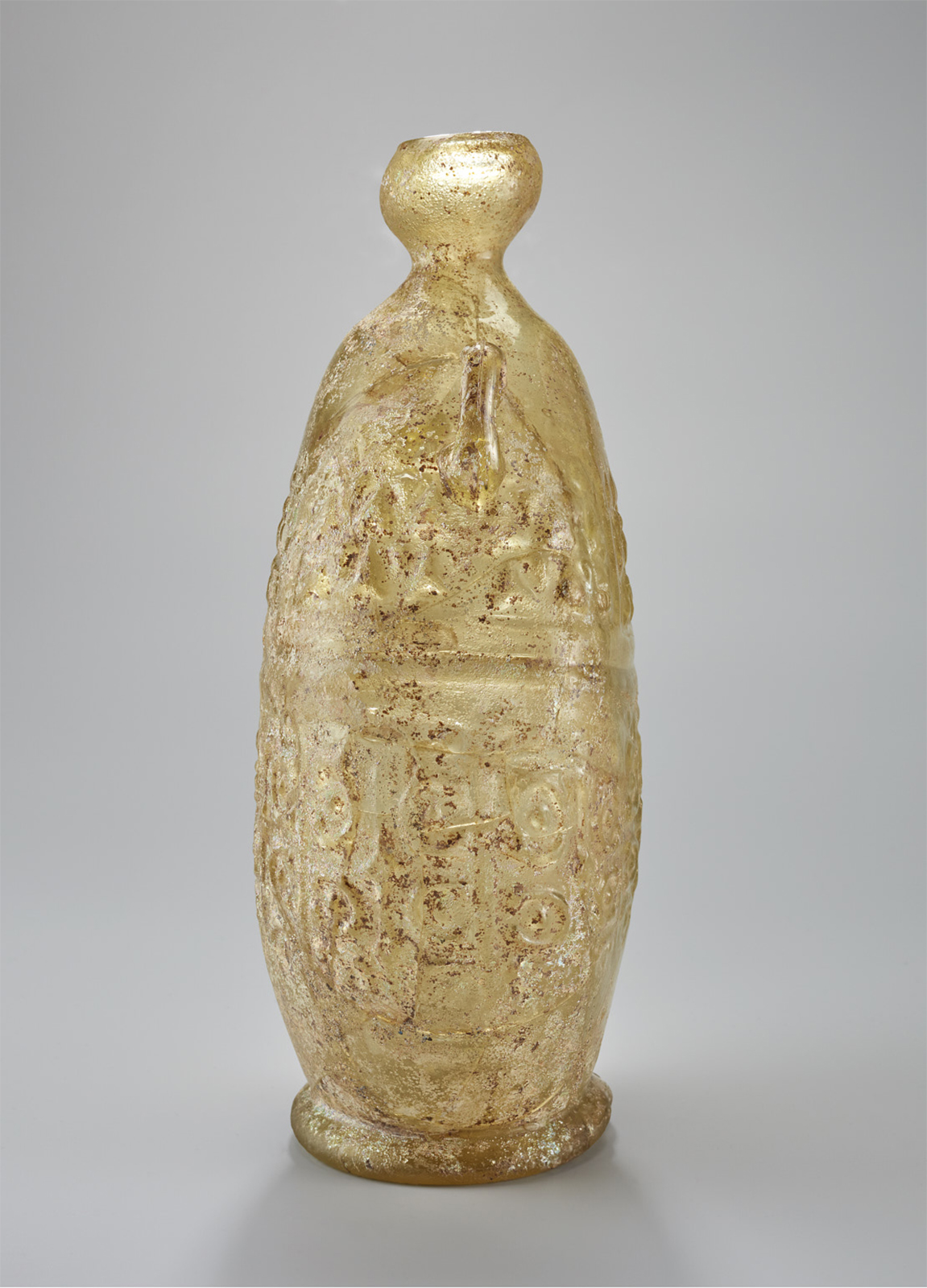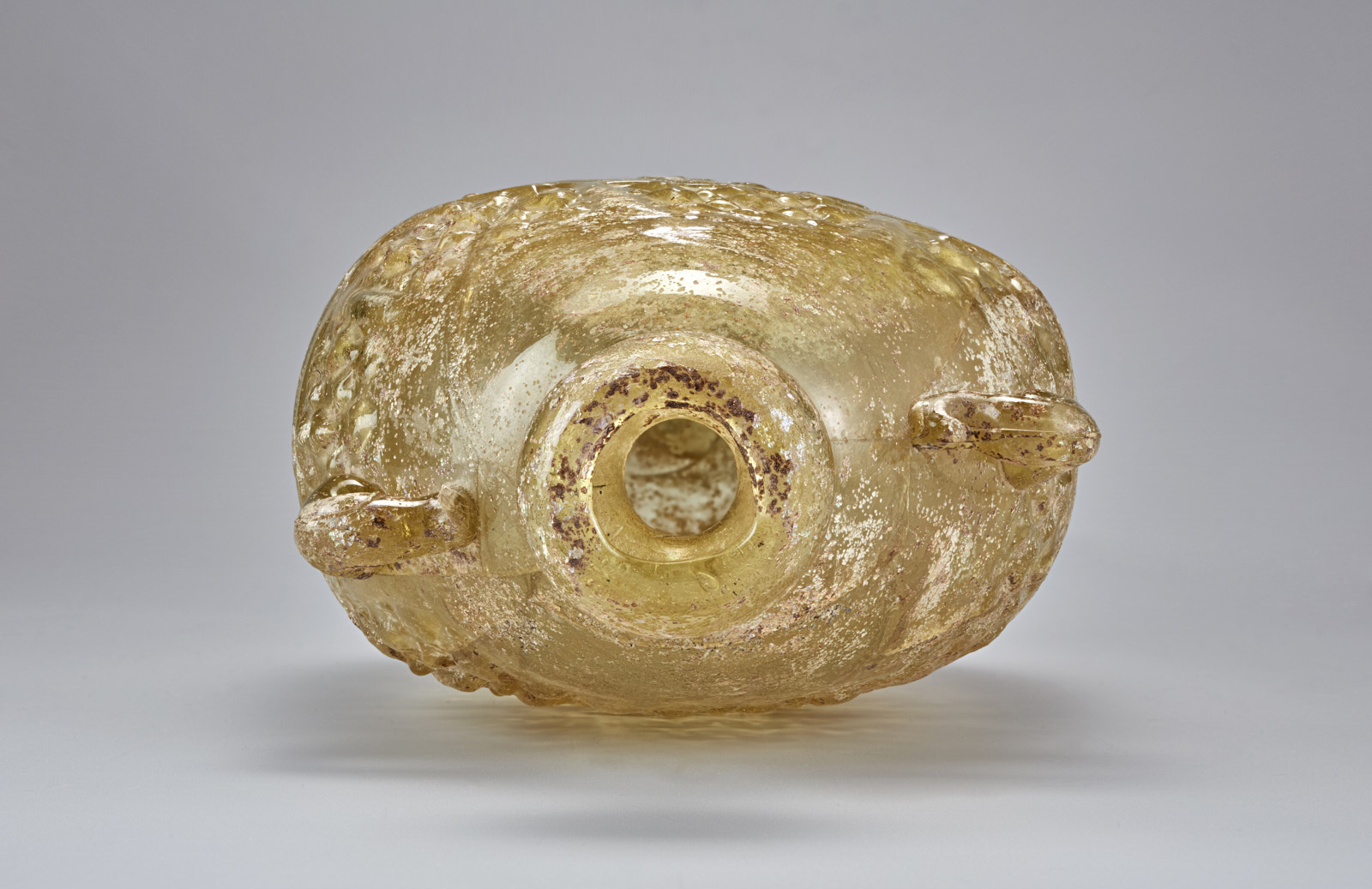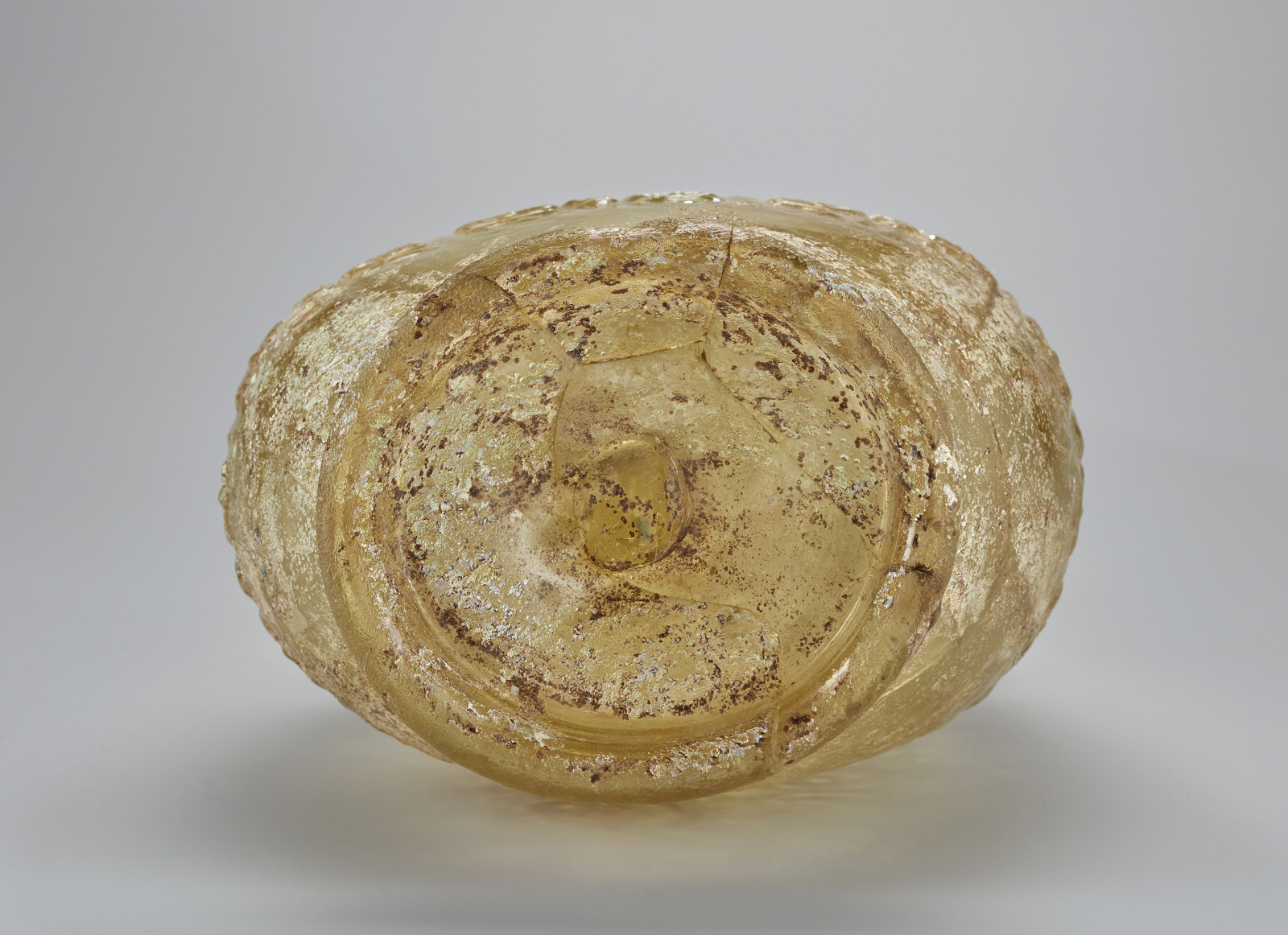Click on the image to zoom
Bottle
- Accession Number:AKM648
- Place:Egypt
- Dimensions:height: 28 cm; diameter: 16.5 cm; diameter of flat side: 11.5 cm
- Date:10th–11th century
- Materials and Technique:glass of honey yellow colour, grayish white weathering; free blown, pattern-pressed and applied, tooled, worked on the pontil
This unusual bottle—formed as an elongated oval with flat sides—seems to have survived without a counterpart. It may have been a utilitarian vessel which glass artisans produced for daily needs. Its rounded oval footring, made by folding, is slightly irregular and has a pontil mark in its centre created by a metal rod with glass added to it. Above its two applied handles, a constricted neck leads to a short, rounded mouth and a rim that folds inwards. Another bottle in the Aga Khan Museum Collection (AKM649) shares this distinctive mouth.
Further Reading
As a horizontal seam across the vessels body shows, this bottle was free-blown using the half-post technique: the glassmaker decorated two sections of the vessel independently and then added them to one object. This technique, which was practised in Egypt as well as in other regions of the Near East, was commonly used either to fuse two differently coloured parts or to fuse two halves with different decorations.
Many surviving bottles with cylindrical necks feature dark blue and colourless glass fused together. Among these vessels, blue glass usually takes the upper part. Such bottles can be found in nearly all major collections, including the Khalili Collection in London,[1] the David Collection in Copenhagen,[2] and the collection of the Metropolitan Museum of Art in New York.[3] The Museum of Islamic Art in Berlin[4] features bottles with fused glass of the same colour that has been decorated in different techniques. This less common type is also known from the excavations in Nishapur/Iran.[5]
The unique bottle from the Aga Khan Museum Collection has been decorated with patterns created by stamps of different sizes. These stamps were pressed continuously onto the glass before the two halves were fused. On the lower part, a rectangular stamp resulted in a pattern divided into two halves by a vertical line with two lozenges. Three half circles are arranged vertically on both sides of the vertical line. Because this decoration was executed by hand, the stamped areas show irregularities. For the decoration of the upper half, a smaller and possibly also rectangular stamp was used, which seems to have a pattern of three-by-three triangles. This stamp was pressed repeatedly on the upper half.
After the two halves were joined, the bottle finally received its handles. Applied on both short sides of the vessel, they are made of thick threads of glass pressed on the vessels wall and then pulled upwards, pressed again on the wall and then pulled out slightly before the thread was cut. The handles indicate that they were probably important for handling the vessel.
The technique of pressing was used extensively for glass vessels of various sizes made in Egypt and Syria, although it was also known in the Iranian region.[6] Stamps had to be pressed quickly while the metal was still hot, sometimes resulting in overlapping patterns. Such overlap can be seen on this bottle in the Aga Khan Museum Collection.
Typical stamp patterns include circles with central points and animals.[7] The two patterns on this bottle, however, are not related to numerous known patterns. The technique of pressing was probably favoured in Egypt from the pre-Fatimid period until the end of this dynasty (909–1171). It may have come to an end in the late Fatimid period.
— Jens Kröger
Notes
[1] Goldstein, 90–91, no. 96 (9.–11.th).
[2] Von Folsach, 206, no. 305.
[3] Jenkins, 20–21, no.19. Carboni and Whitehouse, 101–102, Fig. 92.
[4] Kühn, 88–89, no. 14 and 94–5, no. 17.
[5] Kröger, 100–102, no. 141 (jug).
[6] Carboni, 286–287 nos. 3.55a-f. Carboni and Whitehouse, 101, nos. 43–52.
[7] Carboni, 261–267, 284–85.
References
Carboni, Stefano. Glass from Islamic Lands. The Al-Sabah Collection. Kuwait National Museum. New York: Thames and Hudson, 2001. ISBN: 9780500976067
---. and David Whitehouse, with contributions by Robert H. Brill and William Gudenrath. Glass of the Sultans. New York: The Metropolitan Museum of Art; Corning, NY: The Corning Museum of Glass; Athens: Benaki Museum; New Haven: Yale University Press, 2001. ISBN: 9780300088519
Folsach, Kjeld von. Art from the World of Islam in The David Collection. Copenhagen: F. Hendriksens Eftf, 2001. ISBN: 9788788464214
Goldstein, Sidney. Glass From Sasanian Antecedents to European Imitations, The Nasser D. Khalili Collection of Islamic Art XV. London: The Nour Foundation in Association with Azimuth Editions, 2005. ISBN: 9781874780502
Jenkins, Marilyn D., “Islamic Glass: A Brief History." The Metropolitan Museum of Art Bulletin 44, no. 2 (1986).
Kühn, Miriam with contributions by Andrea Becker and Jens Kröger. Vorsicht Glas! Zerbrechliche Kunst 700–2010. Berlin: Museum für Islamische Kunst - Staatliche Museen zu Berlin, 2010. ISBN: 9783938832691
Note: This online resource is reviewed and updated on an ongoing basis. We are committed to improving this information and will revise and update knowledge about this object as it becomes available.






